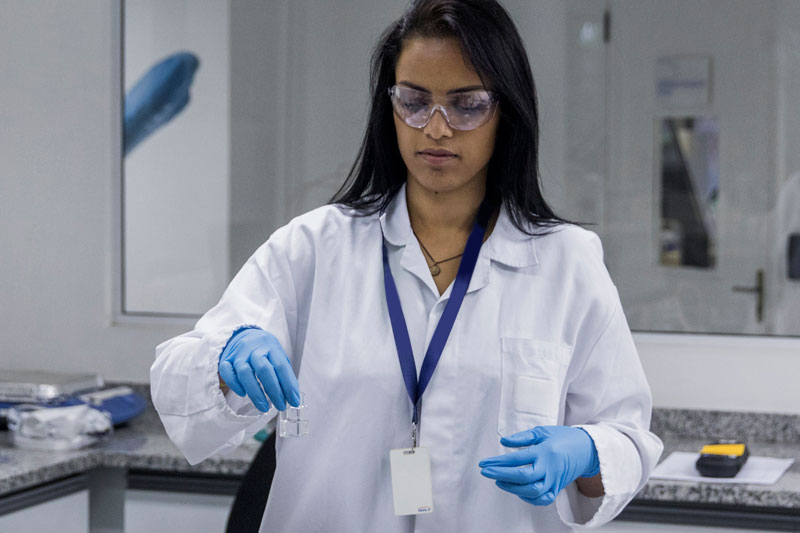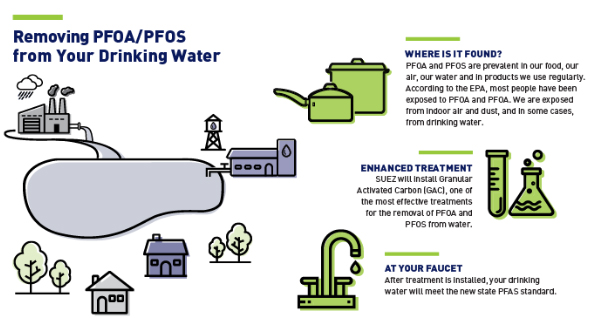

Veolia will install Granular Activated Carbon (GAC), one of the most effective treatments for the removal of PFOA and PFOS from water.
GAC is made from raw organic materials (such as coconut shells or coal) that are high in carbon. Heat, in the absence of oxygen, is used to increase (or activate) the surface area of the carbon; this is why these filters are sometimes referred to as “charcoal” filters. Certain chemicals that are dissolved in water, including PFOA and PFOS, pass through a filter containing GAC and are trapped (or adsorbed).
GAC filters also can be used to remove chemicals that give objectionable odors or tastes to water such as hydrogen sulfide (rotten eggs odor) or chlorine.
Veolia is dedicated to providing customers with water that is safe. At Veolia, we take great pride in our ability to provide you with drinking water that meets — and often surpasses — all the health and safety standards set by the United States Environmental Protection Agency (USEPA), the New York State Department of Environmental Conservation (NYSDEC) and the New York State Department of Health (NYSDOH).
Our annual Water Quality Report reflects the many tests that we perform on your drinking water and shows how it measured up to government standards each year. All the test results are on file with the NYSDOH, the agency that monitors and regulates drinking water quality in our state. Both the EPA and the NYSDOH require water suppliers to produce an Annual Water Quality Report for customers.
How could I be exposed to PFOA and PFOS?
PFOA and PFOS are prevalent in our food, our air, our water and in products we use regularly. According to the EPA, most people have been exposed to PFOA and PFOS. We are exposed from indoor air and dust, and in some cases, from drinking water. Food, air, and water have become contaminated globally as a result of manufacturing releases and through the use of products that contain these substances.
Food: These substances can build up in crops, fish and livestock, ultimately contaminating the food we eat. In addition, when PFOA and PFOS are used in food packaging, such as sandwich wrappers and takeout containers, they migrate to our food.
Indoor air and dust: When PFOA and PFOS are used in products such as stain-proofing for furniture and carpets or waterproofing for clothing, these items become “PFOA and PFOS factories,” releasing the chemicals over time into air and dust.
Drinking water: In most areas, use of firefighting foam and manufacturing appear to be the pollution sources for drinking water, but these substances can find their way into drinking water systems when manufacturing by-products from household products that contain PFOA and PFOS are released. These substances are resilient and mobile and can also come from the air or migrate through soil.
Home and workplace products: PFOA and PFOS use in cleaners, personal care products and specialty products such as ski wax can lead to direct exposure from product use.
Progress on our plan
Veolia received a deferral from the New York State Department of Health on January 8, 2021 for the implementation of treatment for PFOA and PFOS in Rockland County, recognizing the design, testing, permitting, construction and other activities will take time to complete. As part of the deferral process, the company submitted a full action plan that will ensure that the water system will meet the new standard and will produce a quarterly report as a further requirement. The Company requested an extension of the deferral, which included an updated action plan in July 2022 due to delays in receiving local approvals for required permits to begin the construction of the treatment facility.
Veolia also received a deferral from the New York State Department of Health January 7, 2021 for the implementation of treatment for PFOA and PFOS in Putnam County, also recognizing the design, testing, permitting, construction and other activities will take time to complete. Similarly, the company submitted a full action plan that will ensure that the water system will meet the new standard and will produce a quarterly report for its Putnam County water systems that require further treatment. Veolia requested an extension of the deferral, which included an updated action plan in July 2022 due to delays in receiving the required permits to begin the construction of the treatment facility.
On August 23, 2022, Veolia received a deferral from the New York State Department of Health for the implementation of treatment for PFOA and PFOS in Rockland and Putnam counties.
Note: The information contained on this website and in the associated attached reports pertaining to Per- and Polyfluoroalkyl Substances (PFAS) is based on the existing federal and state regulations and on the state of Veolia’s understanding and knowledge of the available federal and state guidelines as of the time of publication.
Please read our most recent reports on the matter below:
What’s next for PFAS?
On June 29, 2021, Veolia and the New York League of Conservation Voters co-hosted a virtual public forum titled, “What’s Next For PFAS,” that featured national, state and business leaders who discussed the latest in PFAS research and remediation efforts in drinking water. Julie Tighe, the President of the NYLCV, moderated the panel, which included:
- Dr. Peter Grevatt, CEO, The Water Research Foundation
- Tracy Mehan, Executive Director of Government Affairs, AWWA
- Dan Shapley, Co-Director of Science-Patrol Program, Hudson Riverkeeper
- Carol Walczyk, Vice President of Water Quality and Compliance, Veolia
